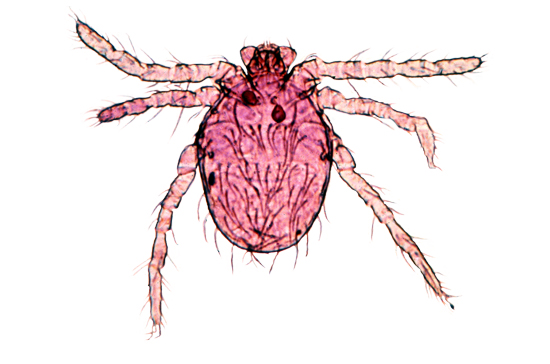Public Health
CHIGGERS
Timothy J. Gibb, Extension Entomologist
If you want to view as pdf, click here
CHIGGER IMPORTANCE/BIOLOGY
A chigger is a tiny parasitic mite, scarcely visible to the human eye. It attacks people, birds, reptiles, and other animals, causing red welts and severe itching.
Chiggers prefer mild climates and are therefore more numerous in Southern Indiana than in the northern part of the state. They are most likely to be encountered in briar patches, uncut grass, and weeds, but may also infest well-kept shrubbery and lawns.
Chiggers hatch from eggs. The newly hatched larvae then crawl about over vegetation, waiting for an animal or human on which to feed. Chiggers usually remain on the host for 2-4 days and then drop off to become nymphs and later adult mites. Only the larvae are parasites of people and other vertebrates.
On people, chiggers usually feed where clothing fits tightly against the body, such as around the ankles, waist, and arm pits. They feed by piercing the skin and injecting a fluid that dissolves the nearby tissue so it can be sucked up for food. This is what causes the red welts and severe itching. These irritations may not show up until several hours or even a day later, thus making it hard to tell when or where exposure took place. Injury is largely a matter of intense itching and irritation, and some people seem more susceptible than others. Chiggers in the U.S. are not known to transmit disease, although secondary infections may occur as a result of scratching.
CHIGGER CONTROL
Insecticides for Infested Areas
Recreational areas, such as lawns, parks, campgrounds, and golf courses, can be treated with such insecticides as diazinon - sprays, granulars, dusts; carbaryl (Sevin) - sprays, and malathion - sprays, dusts. Retreatment may be necessary after 2-3 weeks. Treat the grass, shrubbery, and other vegetation with which people may come in contact. Do not treat areas where livestock feed or graze. Keep children and pets off treated area until dry. Follow label directions, and always observe label precautions when using these or any other insecticides.
Repellents
Insect repellents will prevent chigger bites. Among the best are those containing diethyl toluamide (DEET) and permethrin. Apply the repellent to clothing around the ankles, waist and arms.
Treatment After Exposure
Repellents are useful in preventing chigger bites. Bathing in hot, soapy water as soon as possible after exposure will reduce the number of bites. Once welts appear, little can be done, although local anesthetics (as prescribed by a physician) may lessen the irritation and itching.

Chigger Eutrombicula alfreddug (Oudemans)
READ AND FOLLOW ALL LABEL INSTRUCTIONS. THIS INCLUDES DIRECTIONS FOR USE, PRECAUTIONARY STATEMENTS (HAZARDS TO HUMANS, DOMESTIC ANIMALS, AND ENDANGERED SPECIES), ENVIRONMENTAL HAZARDS, RATES OF APPLICATION, NUMBER OF APPLICATIONS, REENTRY INTERVALS, HARVEST RESTRICTIONS, STORAGE AND DISPOSAL, AND ANY SPECIFIC WARNINGS AND/OR PRECAUTIONS FOR SAFE HANDLING OF THE PESTICIDE.
December 2016

It is the policy of the Purdue University Cooperative Extension Service that all persons have equal opportunity and access to its educational programs, services, activities, and facilities without regard to race, religion, color, sex, age, national origin or ancestry, marital status, parental status, sexual orientation, disability or status as a veteran. Purdue University is an Affirmative Action institution. This material may be available in alternative formats.
This work is supported in part by Extension Implementation Grant 2017-70006-27140/ IND011460G4-1013877 from the USDA National Institute of Food and Agriculture.
1-888-EXT-INFO
www.extension.purdue.edu
Order or download materials from www.the-education-store.com


